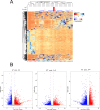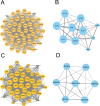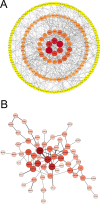Analysing transcriptomic signatures and identifying potential genes for the protective effect of inactivated COVID-19 vaccines
- PMID: 37096063
- PMCID: PMC10122457
- DOI: 10.7717/peerj.15155
Analysing transcriptomic signatures and identifying potential genes for the protective effect of inactivated COVID-19 vaccines
Abstract
Inactivated vaccines are one of the most effective strategies for controlling the coronavirus disease 2019 (COVID-19) pandemic. However, the response genes for the protective effect of inactivated vaccines are still unclear. Herein, we analysed the neutralization antibody responses elicited by vaccine serum and carried out transcriptome sequencing of RNAs isolated from the PBMCs of 29 medical staff receiving two doses of the CoronaVac vaccine. The results showed that SARS-CoV-2 neutralization antibody titers varied considerably among individuals, and revealed that many innate immune pathways were activated after vaccination. Furthermore, the blue module revealed that NRAS, YWHAB, SMARCA5, PPP1CC and CDC5L may be correlated with the protective effect of the inactivated vaccine. Additionally, MAPK1, CDC42, PPP2CA, EP300, YWHAZ and NRAS were demonstrated as the hub genes having a significant association with vaccines. These findings provide a basis for understanding the molecular mechanism of the host immune response induced by inactivated vaccines.
Keywords: Inactivated vaccine; Neutralization antibody; RNA-seq; SARS-CoV-2; Transcriptome profile.
©2023 Chen et al.
Conflict of interest statement
The authors declare there are no competing interests.
Figures





Similar articles
-
Single-cell transcriptomic atlas reveals distinct immunological responses between COVID-19 vaccine and natural SARS-CoV-2 infection.J Med Virol. 2022 Nov;94(11):5304-5324. doi: 10.1002/jmv.28012. Epub 2022 Jul 30. J Med Virol. 2022. PMID: 35859327 Free PMC article.
-
Transcriptome Analysis of Peripheral Blood Mononuclear Cells in SARS-CoV-2 Naïve and Recovered Individuals Vaccinated With Inactivated Vaccine.Front Cell Infect Microbiol. 2022 Feb 3;11:821828. doi: 10.3389/fcimb.2021.821828. eCollection 2021. Front Cell Infect Microbiol. 2022. PMID: 35186784 Free PMC article.
-
Characterization of SARS-CoV-2-Specific Humoral and Cellular Immune Responses Induced by Inactivated COVID-19 Vaccines in a Real-World Setting.Front Immunol. 2021 Dec 22;12:802858. doi: 10.3389/fimmu.2021.802858. eCollection 2021. Front Immunol. 2021. PMID: 35003131 Free PMC article.
-
Immunogenicity and immune-persistence of the CoronaVac or Covilo inactivated COVID-19 Vaccine: a 6-month population-based cohort study.Front Immunol. 2022 Aug 12;13:939311. doi: 10.3389/fimmu.2022.939311. eCollection 2022. Front Immunol. 2022. PMID: 36032136 Free PMC article.
-
CoronaVac: A review of efficacy, safety, and immunogenicity of the inactivated vaccine against SARS-CoV-2.Hum Vaccin Immunother. 2022 Nov 30;18(6):2096970. doi: 10.1080/21645515.2022.2096970. Epub 2022 Jul 25. Hum Vaccin Immunother. 2022. PMID: 35878789 Free PMC article. Review.
Cited by
-
Altered expression of miRNA profile in peripheral blood mononuclear cells following the third dose of inactivated COVID-19 vaccine.PeerJ. 2025 Jan 22;13:e18856. doi: 10.7717/peerj.18856. eCollection 2025. PeerJ. 2025. PMID: 39866557 Free PMC article.
-
Immune response stability to the SARS-CoV-2 mRNA vaccine booster is influenced by differential splicing of HLA genes.Sci Rep. 2024 Apr 18;14(1):8982. doi: 10.1038/s41598-024-59259-1. Sci Rep. 2024. PMID: 38637586 Free PMC article.
References
-
- Abu-Raddad LJ, Chemaitelly H, Ayoub HH, Coyle P, Malek JA, Ahmed AA, Mohamoud YA, Younuskunju S, Tang P, Al Kanaani Z, Al Kuwari E, Butt AA, Jeremijenko A, Kaleeckal AH, Latif AN, Shaik RM, Abdul Rahim HF, Nasrallah GK, Yassine HM, Al Kuwari MG, Al Romaihi HE, Al-Thani MH, Al Khal A, Bertollini R. Introduction and expansion of the SARS-CoV-2 B.1.1.7 variant and reinfections in Qatar: a nationally representative cohort study. PLOS Medicine. 2021;18:e1003879. doi: 10.1371/journal.pmed.1003879. - DOI - PMC - PubMed
-
- Alcorn JF, Avula R, Chakka AB, Schwarzmann WE, Nowalk MP, Lin CJ, Ortiz MA, Horne WT, Chandran UR, Nagg JP, Zimmerman RK, Cole KS, Moehling KK, Martin JM. Differential gene expression in peripheral blood mononuclear cells from children immunized with inactivated influenza vaccine. Human Vaccines & Immunotherapeutics. 2020;16:1782–1790. doi: 10.1080/21645515.2020.1711677. - DOI - PMC - PubMed
-
- Ali K, Berman G, Zhou H, Deng W, Faughnan V, Coronado-Voges M, Ding B, Dooley J, Girard B, Hillebrand W, Pajon R, Miller JM, Leav B, McPhee R. Evaluation of mRNA-1273 SARS-CoV-2 Vaccine in Adolescents. The New England Journal of Medicine. 2021;385:2241–2251. doi: 10.1056/NEJMoa2109522. - DOI - PMC - PubMed
-
- Arunachalam PS, Scott MKD, Hagan T, Li C, Feng Y, Wimmers F, Grigoryan L, Trisal M, Edara VV, Lai L, Chang SE, Feng A, Dhingra S, Shah M, Lee AS, Chinthrajah S, Sindher SB, Mallajosyula V, Gao F, Sigal N, Kowli S, Gupta S, Pellegrini K, Tharp G, Maysel-Auslender S, Hamilton S, Aoued H, Hrusovsky K, Roskey M, Bosinger SE, Maecker HT, Boyd SD, Davis MM, Utz PJ, Suthar MS, Khatri P, Nadeau KC, Pulendran B. Systems vaccinology of the BNT162b2 mRNA vaccine in humans. Nature. 2021;596:410–416. doi: 10.1038/s41586-021-03791-x. - DOI - PMC - PubMed
Publication types
MeSH terms
Substances
LinkOut - more resources
Full Text Sources
Medical
Research Materials
Miscellaneous

